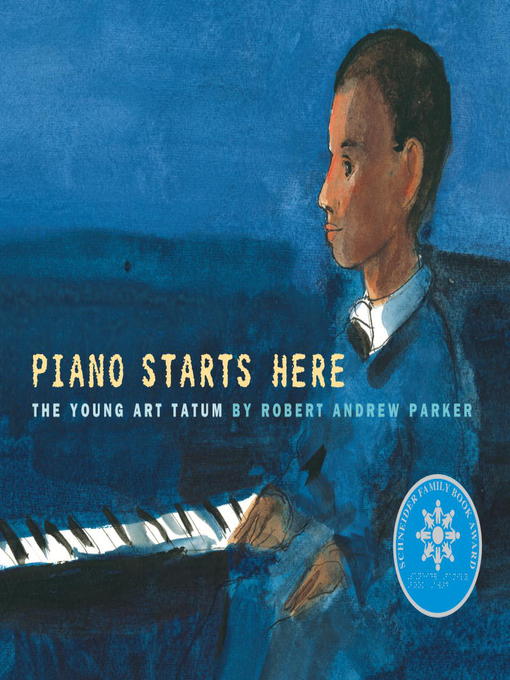
Piano Starts Here
The Young Art Tatum
فرمت کتاب
ebook
تاریخ انتشار
2012
Lexile Score
750
Reading Level
3-4
ATOS
4.7
Interest Level
K-3(LG)
نویسنده
Robert Andrew Parkerشابک
9780307983558
کتاب های مرتبط
- اطلاعات
- نقد و بررسی
- دیدگاه کاربران
نقد و بررسی

December 24, 2007
Parker, who illustrated Ballet of the Elephants
and Action Jackson
, makes his writing debut with a biography of famed jazz pianist Art Tatum, which takes some creative license in its straightforward, first-person narrative. “Bad eyes can't keep me from playing the piano,” says a young Tatum. “My hands get to know the keys, the short black ones on top and long white ones below. I play more and more. And more.” The uncluttered storytelling offers a chronological journey of Tatum's rise to fame: his first recital in church; a night of playing moon-themed songs while neighborhood children catch fireflies; his first gig at a bar. From the twins next door who help him walk to school to a café owner who lets him use his player piano, the story incorporates the people who were important in Tatum's early life—his hardworking parents, foremost. A subtle sophistication shines through Parker's easygoing yet dynamic watercolors. Roughly hewn sketch lines give the characters an almost abstract quality, but their faces and gestures project emotion nonetheless, as in vignettes of a bartender smiling contentedly or Tatum's mother sitting in the shadows by a radio, both listening to Tatum play. Parker's unhurried account could inspire visions of jazz greatness among young musicians. Ages 4-8.

Starred review from February 1, 2008
K-Gr 4-Breathing life into words about music for young children is never easy, but Parker makes it appear effortless. Perhaps this is due, in part, to his own understandings as a jazz musician. His first-person account about the early years of Tatum's life is a feast for the senses. Beautifully paced, spare sentences accompany introductory watercolors of the legendary jazz pianist's family. Viewers watch the toddler on tiptoe reaching for the keys that provided delight to him from this early stage. As the narrative develops and Tatum's impaired vision begins to fade, the lines lengthen, incorporating the sounds, smells, and physical sensations that were much clearer to him. Listeners can imagine the scents of furniture polish and flowers as the boy plays in church or the vibration of his father's footsteps as he dances to his son's music in the living room. Parker's palette and style vary to create just the right ambience, with compositions ranging from a brightly lit snowscape with realistic figures racing down the path to moody, impressionistic backgrounds swirling around Tatum playing his beloved "Humoresque" on the road as a young man. Notes from the author describe his personal encounter with the musician and provide an overview of his life. A bibliography of adult resources is included; there is little available for children. Showcase this title with Chris Raschka's "Charlie Parker Played Be Bop" (Scholastic, 1992) and Andrea Davis Pinkney's "Ella Fitzgerald" (Hyperion, 2002) along with some CDs for a joint-jumping, heart-pumping ride."Wendy Lukehart, Washington DC Public Library"
Copyright 2008 School Library Journal, LLC Used with permission.

Starred review from February 1, 2008
Parker, who illustrated Jan Greenberg and Sandra Jordans Sibert Honor Book Action Jackson (2002), contributes both words and pictures in this heartfelt portrait of jazz great Tatum. Parker pushes the limits of the books nonfiction cataloguing by speaking in the pianistsfirst-person voice, but an authors note and a solid bibliography set the episodes in a framework of established facts. The vibrant scenes, in Parkers familiar style of scratched ink lines and watercolor washes, show young Tatum playing at home for his dancing parents, at church for a full choir, and at local clubs, where he is discovered and his international career begins. In some images, crowds of dancers and musicians create a swirl of animated motion; in others, Parker sets Tatum, who was nearly blind, against a deep, moody, abstract background of shifting colors. Throughout, the simple, direct language shows the power of the music for both Tatum and his listeners. When I am at the piano . . . I play clouds of notes, rivers of notes . . . I forget that my eyes arent good. I have everything I need. Cue up the music; children will best appreciate this beautiful tribute with an earful of Tatum at the keyboard.(Reprinted with permission of Booklist, copyright 2008, American Library Association.)

























دیدگاه کاربران